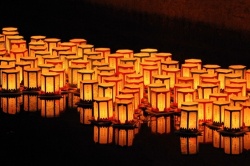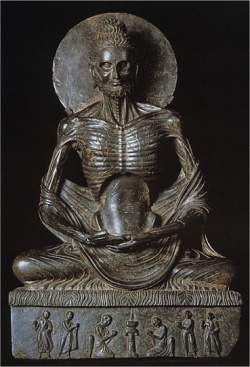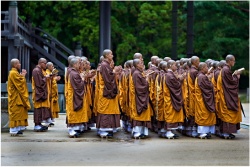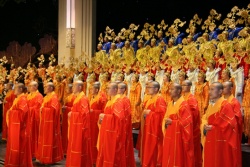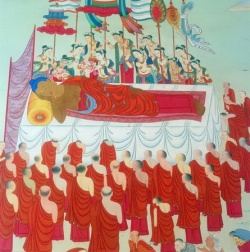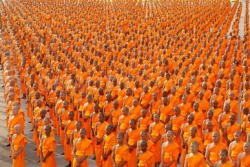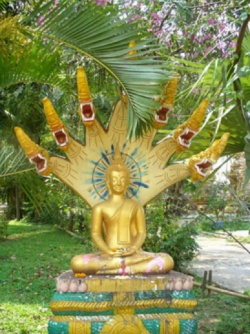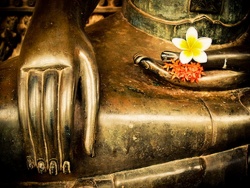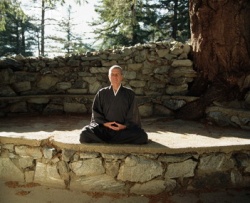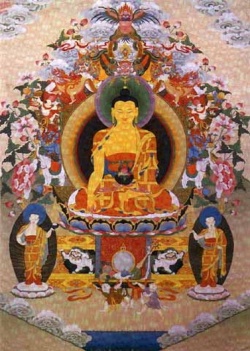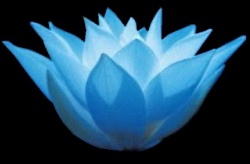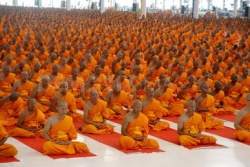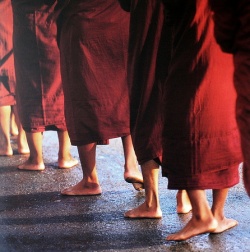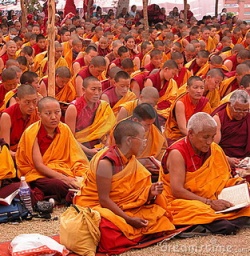Difference between revisions of "Higher Education in Laos: The Academic Activities of the Two Sangha Colleges"
m (1 revision: Robo text replace 30 sept) |
|||
| Line 6: | Line 6: | ||
Introduction | Introduction | ||
[[File:31japan.jpg|thumb|250px|]] | [[File:31japan.jpg|thumb|250px|]] | ||
| − | In the olden days, as in many other countries, [[education]] in [[Laos]] was conducted in [[monasteries]], where [[monks]] were trained and educated for years, and then gave advises to both [[Sangha]] [[Order]] themselves and laypeople. [[Traditionally]], Lao man had to be [[ordained]] once in a [[lifetime]] to gain [[monastic]] [[education]]. Even after he disrobed and lived as a [[householder]], he was considered a literate [[person]], a [[wise]] man or a ripe [[person]] while untrained ones were illiterate, a raw man (one who has never been a [[monk]] or [[novice]]). In the {{Wiki|modern}} days, the [[education]] has expanded [[beyond]] walls of [[monasteries]]. Still [[monastic]] [[education]] is necessary to carry on, to improve more and more to catch up with the [[worldly]] [[education]] in term of developing the quality and standardization of [[education]]. In this paper, I am going to discuss mainly about the [[Buddhist]] [[education]] in [[Laos]] which base on the higher [[Buddhist]] educational {{Wiki|institutions}}, the [[Sangha]] {{Wiki|Colleges}} particularly [[Buddhist studies]] are conducted. | + | In the olden days, as in many other countries, [[education]] in [[Laos]] was conducted in [[monasteries]], where [[monks]] were trained and educated for years, and then gave advises to both [[Sangha]] [[Order]] themselves and [[laypeople]]. [[Traditionally]], Lao man had to be [[ordained]] once in a [[lifetime]] to gain [[monastic]] [[education]]. Even after he [[disrobed]] and lived as a [[householder]], he was considered a literate [[person]], a [[wise]] man or a ripe [[person]] while untrained ones were illiterate, a raw man (one who has never been a [[monk]] or [[novice]]). In the {{Wiki|modern}} days, the [[education]] has expanded [[beyond]] walls of [[monasteries]]. Still [[monastic]] [[education]] is necessary to carry on, to improve more and more to catch up with the [[worldly]] [[education]] in term of developing the [[quality]] and standardization of [[education]]. In this paper, I am going to discuss mainly about the [[Buddhist]] [[education]] in [[Laos]] which base on the higher [[Buddhist]] educational {{Wiki|institutions}}, the [[Sangha]] {{Wiki|Colleges}} particularly [[Buddhist studies]] are conducted. |
[[File:30b380ae357.jpg|thumb|250px|]] | [[File:30b380ae357.jpg|thumb|250px|]] | ||
Historical Background of the two [[Sangha]] {{Wiki|Colleges}} | Historical Background of the two [[Sangha]] {{Wiki|Colleges}} | ||
[[File:92 271.jpg|thumb|250px|]] | [[File:92 271.jpg|thumb|250px|]] | ||
| − | [[Sangha]] College in {{Wiki|Vientiane}} | + | [[Sangha]] {{Wiki|College}} in {{Wiki|Vientiane}} |
[[File:304.jpg|thumb|250px|]] | [[File:304.jpg|thumb|250px|]] | ||
| − | The [[Sangha]] College was initially established in 1929(2472) by {{Wiki|Prince}} Phetsarath and Somdet Phra Loukeo Uthen Sakda, the [[Supreme]] [[Patriarch]] of Lao [[Sangha]] who was also the governor of {{Wiki|Vientiane}}. Initially it was known as the [[Pariyatti Dhamma]] School, and was located in the vicinity of the current Presidential Palace. The school taught [[Dhamma]], [[Vinaya]], [[Pāḷi]], the [[life of the Buddha]], Tham script (the script used to inscribe in palm leaf {{Wiki|manuscript}} and in the former [[time]] both Tham and Lao scripts were officially used in [[writing]] system), Lao and Khmer [[languages]], and {{Wiki|mathematics}}. At that [[time]], there were up to 150 students and 4 [[teachers]]. | + | The [[Sangha]] {{Wiki|College}} was initially established in 1929(2472) by {{Wiki|Prince}} Phetsarath and [[Somdet Phra]] Loukeo Uthen Sakda, the [[Supreme]] [[Patriarch]] of Lao [[Sangha]] who was also the governor of {{Wiki|Vientiane}}. Initially it was known as the [[Pariyatti Dhamma]] School, and was located in the vicinity of the current Presidential Palace. The school [[taught]] [[Dhamma]], [[Vinaya]], [[Pāḷi]], the [[life of the Buddha]], Tham [[script]] (the [[script]] used to inscribe in palm leaf {{Wiki|manuscript}} and in the former [[time]] both Tham and Lao scripts were officially used in [[writing]] system), Lao and {{Wiki|Khmer}} [[languages]], and {{Wiki|mathematics}}. At that [[time]], there were up to 150 students and 4 [[teachers]]. |
[[File:AsNagas.jpg|thumb|250px|]] | [[File:AsNagas.jpg|thumb|250px|]] | ||
| − | In the 1930s, Mr. [[Maha Sila]] Viravong was the director; during that [[time]] the Palm Leaf {{Wiki|Manuscript}} Library was established within the school and a program for [[Buddhist]] Arts was set up also in Chanthabouri [[Vihara]], where the college had been relocated and another branch was established in {{Wiki|Luang Prabang}}, opened in 1932. In 1950(2493), the [[Pariyatti Dhamma]] School was moved to Wat Sithane Neua under the [[direction]] of the Most [[Venerable]] Phra Achan Bouakham Voraphet. | + | In the 1930s, Mr. [[Maha Sila]] Viravong was the director; during that [[time]] the Palm Leaf {{Wiki|Manuscript}} Library was established within the school and a program for [[Buddhist]] [[Arts]] was set up also in Chanthabouri [[Vihara]], where the {{Wiki|college}} had been relocated and another branch was established in {{Wiki|Luang Prabang}}, opened in 1932. In 1950(2493), the [[Pariyatti Dhamma]] School was moved to Wat Sithane Neua under the [[direction]] of the Most [[Venerable]] [[Phra]] Achan Bouakham Voraphet. |
[[File:331708 n.jpg|thumb|250px|]] | [[File:331708 n.jpg|thumb|250px|]] | ||
| − | After the nation gained {{Wiki|independence}} in 1953(2496), the school came under the Ministry of Cults; then was moved to Wat Ongtue [[Mahavihara]], Chanthaboury district, {{Wiki|Vientiane}}, renamed the [[Pāḷi]] Institute, which was open to all [[monks]] and novices who graduated from high schools. The Institute [[offered]] a four- year program including the preparatory class. This [[time]] there were additional [[subjects]], for example, geography, {{Wiki|history}} and {{Wiki|French}}. | + | After the {{Wiki|nation}} gained {{Wiki|independence}} in 1953(2496), the school came under the Ministry of Cults; then was moved to Wat Ongtue [[Mahavihara]], Chanthaboury district, {{Wiki|Vientiane}}, renamed the [[Pāḷi]] Institute, which was open to all [[monks]] and novices who graduated from high schools. The Institute [[offered]] a four- year program including the preparatory class. This [[time]] there were additional [[subjects]], for example, {{Wiki|geography}}, {{Wiki|history}} and {{Wiki|French}}. |
[[File:33161q.jpg|thumb|250px|]] | [[File:33161q.jpg|thumb|250px|]] | ||
In 1967(2510), in term of administration, the [[Pāḷi]] Institute was transferred to the Department of Higher [[Education]] of the Ministry of [[Education]]; then was renamed the [[Buddhist]] Educational Institute where there were two [[Thai]] [[teachers]], one {{Wiki|French}} [[teacher]], one {{Wiki|English}} [[teacher]] and one [[Indian]] [[teacher]], providing additional [[subjects]] as pedagogical studies, such as {{Wiki|Western philosophy}}, [[Indian philosophy]] and {{Wiki|general}} [[religions]]. | In 1967(2510), in term of administration, the [[Pāḷi]] Institute was transferred to the Department of Higher [[Education]] of the Ministry of [[Education]]; then was renamed the [[Buddhist]] Educational Institute where there were two [[Thai]] [[teachers]], one {{Wiki|French}} [[teacher]], one {{Wiki|English}} [[teacher]] and one [[Indian]] [[teacher]], providing additional [[subjects]] as pedagogical studies, such as {{Wiki|Western philosophy}}, [[Indian philosophy]] and {{Wiki|general}} [[religions]]. | ||
[[File:Bjtk090a.jpg|thumb|250px|]] | [[File:Bjtk090a.jpg|thumb|250px|]] | ||
| − | From 1976(2519), as for the {{Wiki|academic}} aspect, the Institute started to offer a six-year Higher Diploma Program equivalent to a {{Wiki|Bachelor}} {{Wiki|Degree}}. Students who completed the program could teach the [[Primary]] and Middle [[Teacher]] Training Schools. This [[time]] it falls under the responsibility of the Department of Vocational [[Teacher]] Training, the Ministry of [[Education]]. | + | From 1976(2519), as for the {{Wiki|academic}} aspect, the Institute started to offer a six-year Higher Diploma Program {{Wiki|equivalent}} to a {{Wiki|Bachelor}} {{Wiki|Degree}}. Students who completed the program could teach the [[Primary]] and Middle [[Teacher]] Training Schools. This [[time]] it falls under the {{Wiki|responsibility}} of the Department of Vocational [[Teacher]] Training, the Ministry of [[Education]]. |
[[File:Bl 58.jpg|thumb|250px|]] | [[File:Bl 58.jpg|thumb|250px|]] | ||
| − | 1996(2539), the Institute was renamed the [[Sangha]] College up to the present, offers a four –year program, a Higher Diploma {{Wiki|Degree}}, which is equivalent to {{Wiki|Bachelor}} {{Wiki|Degree}}. It is divided into two [[faculties]]: Faculty of [[Education]] and Faculty of Arts, under the {{Wiki|patronage}} of the Ministry of [[Education]], the Lao [[Buddhist]] Fellowship Organization and in cooperation with the Lao Front for National Construction. So far, the [[Sangha]] College has produced 6 batches of 258 students who can teach at the [[Buddhist]] high schools and work for [[Buddhist]] offices in different provinces throughout the country. | + | 1996(2539), the Institute was renamed the [[Sangha]] {{Wiki|College}} up to the {{Wiki|present}}, offers a four –year program, a Higher Diploma {{Wiki|Degree}}, which is {{Wiki|equivalent}} to {{Wiki|Bachelor}} {{Wiki|Degree}}. It is divided into two [[faculties]]: Faculty of [[Education]] and Faculty of [[Arts]], under the {{Wiki|patronage}} of the Ministry of [[Education]], the Lao [[Buddhist]] Fellowship [[Organization]] and in cooperation with the Lao Front for National Construction. So far, the [[Sangha]] {{Wiki|College}} has produced 6 batches of 258 students who can teach at the [[Buddhist]] high schools and work for [[Buddhist]] offices in different provinces throughout the country. |
[[File:Blue Lot hin.jpg|thumb|250px|]] | [[File:Blue Lot hin.jpg|thumb|250px|]] | ||
[[File:348385.jpg|thumb|250px|]] | [[File:348385.jpg|thumb|250px|]] | ||
| − | Champasak [[Sangha]] College | + | Champasak [[Sangha]] {{Wiki|College}} |
[[File:Bu ot .jpg|thumb|250px|]] | [[File:Bu ot .jpg|thumb|250px|]] | ||
| − | Long before the establishment of the Champasak [[Sangha]] College, [[Buddhist]] [[education]] has existed and evolved in [[monasteries]] from [[primary]] up to intermediate levels. The emphasis on [[Pāḷi]] and [[Dhamma]] studies; this was more of the case in Champasak district, where there were one [[primary]] [[pariyatti]] school at Wat Nakhonevanaram and another school was at Wat Yuttidhammadhara (Wat Thong). Some secular [[subjects]], in particular, {{Wiki|mathematics}}, were introduced in [[monastic]] schools. In addition, in some [[monasteries]], where there were not [[Pariyatti]] Schools, [[Pāḷi]] was taught in [[form]] of oral memorization (Mukhapāda), for example, Mūlakaccāyana [[Pāḷi]] which the older generation of [[monks]] learned individually from their [[teachers]]. | + | Long before the establishment of the Champasak [[Sangha]] {{Wiki|College}}, [[Buddhist]] [[education]] has existed and evolved in [[monasteries]] from [[primary]] up to [[intermediate]] levels. The {{Wiki|emphasis}} on [[Pāḷi]] and [[Dhamma]] studies; this was more of the case in Champasak district, where there were one [[primary]] [[pariyatti]] school at Wat Nakhonevanaram and another school was at Wat Yuttidhammadhara (Wat [[Thong]]). Some {{Wiki|secular}} [[subjects]], in particular, {{Wiki|mathematics}}, were introduced in [[monastic]] schools. In addition, in some [[monasteries]], where there were not [[Pariyatti]] Schools, [[Pāḷi]] was [[taught]] in [[form]] of oral [[memorization]] (Mukhapāda), for example, Mūlakaccāyana [[Pāḷi]] which the older generation of [[monks]] learned individually from their [[teachers]]. |
[[File:3518583412.jpg|thumb|250px|]] | [[File:3518583412.jpg|thumb|250px|]] | ||
| − | However, some notable [[Buddhist]] educational development took place in the [[time]] of Most [[Venerable]] Somdet Phra Loukeo Khoun Manivong, the late president of Lao [[Buddhist]] Fellowship Organization (LBFO), when he was a provincial governor of Champasak. In 1940(2483), he established the [[Pariyatti Dhamma]] School in Wat Bodhirattanasasadaram (Wat [[Luang]] Pakse). And in 1942(2485), [[Pāḷi]] School was set up in the same [[monastery]]. [[Buddhist]] [[education]] in Southern [[Laos]] was provided for students who came from the four southern provinces, Khamuane, Savannakhet, Saravan and Champasak. In [[order]] to improve {{Wiki|ecclesiastical}} [[education]], [[teacher]] [[monks]] were sent further training abroad, such as [[Cambodia]], [[Thailand]]. In 1944(2487), Institute Indigène D’études Bouddhiques (Institute of [[Buddhist Studies]]) was established in Wat Bodhirattanasasadaram under the [[direction]] of Somdet Phra Loukeo Khoun Manivong[2], who participated in one of the sessions of the Chaṭṭha Sanghayanā, the [[Sixth Buddhist Council]] in the Union of {{Wiki|Myanmar}}, 1954-56(2498-2500), edited the Aṭṭhakathā (commentary) and was conferred the {{Wiki|Honorary}} Title Aggamahāpanḍitta by the government of {{Wiki|Myanmar}}. | + | However, some notable [[Buddhist]] educational [[development]] took place in the [[time]] of Most [[Venerable]] [[Somdet Phra]] Loukeo Khoun Manivong, the late [[president]] of Lao [[Buddhist]] Fellowship [[Organization]] (LBFO), when he was a provincial governor of Champasak. In 1940(2483), he established the [[Pariyatti Dhamma]] School in Wat Bodhirattanasasadaram (Wat [[Luang]] Pakse). And in 1942(2485), [[Pāḷi]] School was set up in the same [[monastery]]. [[Buddhist]] [[education]] in Southern [[Laos]] was provided for students who came from the four southern provinces, Khamuane, Savannakhet, Saravan and Champasak. In [[order]] to improve {{Wiki|ecclesiastical}} [[education]], [[teacher]] [[monks]] were sent further {{Wiki|training}} abroad, such as [[Cambodia]], [[Thailand]]. In 1944(2487), Institute Indigène D’études Bouddhiques (Institute of [[Buddhist Studies]]) was established in Wat Bodhirattanasasadaram under the [[direction]] of [[Somdet Phra]] Loukeo Khoun Manivong[2], who participated in one of the sessions of the Chaṭṭha Sanghayanā, the [[Sixth Buddhist Council]] in the Union of {{Wiki|Myanmar}}, 1954-56(2498-2500), edited the [[Aṭṭhakathā]] (commentary) and was conferred the {{Wiki|Honorary}} Title Aggamahāpanḍitta by the government of {{Wiki|Myanmar}}. |
[[File:356011.jpg|thumb|250px|]] | [[File:356011.jpg|thumb|250px|]] | ||
| − | We have now seen that [[monastic]] [[education]] in the Champasak Province, especially, at Wat Bodhirattanasasadaram flourished even before the nation gained {{Wiki|independence}} in 1975. After the {{Wiki|independence}}, the [[Pāḷi]] Schools and the Institute of [[Buddhist Studies]] were renamed [[Buddhist]] High School whose {{Wiki|curriculum}} were adapted (the [[form]] of [[Buddhist]] [[Education]] had been [[transformed]] due to many [[reasons]], lack of [[teachers]], etc). Both {{Wiki|ecclesiastical}} and secular [[subjects]] were introduced into the courses. From 1976-1998, the [[Buddhist]] [[education]] was under the [[direction]] of Phraku Bhavanābhilom (Somsi Keokhiew), the late [[Sangha]] governor of Champasak province. In 2004, the old [[Buddhist]] High School Building was demolished and [[constructed]] in new site at Wat Dhammarangsi (Wat Thahin), Pakse district under the [[leadership]] of Phra Achan [[Maha]] Suvan Chantharath, the present governor of Champasak province, who fulfilled the will of the late [[Acarya]] Phraku Somsi Keokhiew. | + | We have now seen that [[monastic]] [[education]] in the Champasak Province, especially, at Wat Bodhirattanasasadaram flourished even before the {{Wiki|nation}} gained {{Wiki|independence}} in 1975. After the {{Wiki|independence}}, the [[Pāḷi]] Schools and the Institute of [[Buddhist Studies]] were renamed [[Buddhist]] High School whose {{Wiki|curriculum}} were adapted (the [[form]] of [[Buddhist]] [[Education]] had been [[transformed]] due to many [[reasons]], lack of [[teachers]], etc). Both {{Wiki|ecclesiastical}} and {{Wiki|secular}} [[subjects]] were introduced into the courses. From 1976-1998, the [[Buddhist]] [[education]] was under the [[direction]] of Phraku Bhavanābhilom (Somsi Keokhiew), the late [[Sangha]] governor of Champasak province. In 2004, the old [[Buddhist]] High School Building was demolished and [[constructed]] in new site at Wat Dhammarangsi (Wat Thahin), Pakse district under the [[leadership]] of [[Phra]] Achan [[Maha]] Suvan Chantharath, the {{Wiki|present}} governor of Champasak province, who fulfilled the will of the late [[Acarya]] Phraku Somsi Keokhiew. |
| − | In 2005, Phra Achan [[Maha]] Suvan Chantharath established the [[Sangha]] College by using the old building of [[Pariyatti]] School and Institute of [[Buddhist Studies]]. At the same [[time]], the new building of the [[Sangha]] College is still under construction, next to the Wat Bodhirattanasasadaram, in place of the Tennis yard granted by the government. The Champasak [[Sangha]] College began its first {{Wiki|academic}} year in 2006. | + | In 2005, [[Phra]] Achan [[Maha]] Suvan Chantharath established the [[Sangha]] {{Wiki|College}} by using the old building of [[Pariyatti]] School and Institute of [[Buddhist Studies]]. At the same [[time]], the new building of the [[Sangha]] {{Wiki|College}} is still under construction, next to the Wat Bodhirattanasasadaram, in place of the Tennis yard granted by the government. The Champasak [[Sangha]] {{Wiki|College}} began its first {{Wiki|academic}} year in 2006. |
| − | How [[Pāḷi]], [[Abhidhamma]] and [[Vipassana]] are Taught | + | How [[Pāḷi]], [[Abhidhamma]] and [[Vipassana]] are [[Taught]] |
As the [[Pāḷi]] {{Wiki|canonical}} texts are the authoritative sources of the [[Buddha’s teachings]], it is necessary to study [[Pāḷi]] in [[order]] to get the {{Wiki|real}} meaning of the [[Buddha’s]] words from the [[Pāḷi]] texts. Another [[reason]] is that Lao [[language]] is influenced by [[Pāḷi]], so it is necessary to learn [[Pāḷi]]. | As the [[Pāḷi]] {{Wiki|canonical}} texts are the authoritative sources of the [[Buddha’s teachings]], it is necessary to study [[Pāḷi]] in [[order]] to get the {{Wiki|real}} meaning of the [[Buddha’s]] words from the [[Pāḷi]] texts. Another [[reason]] is that Lao [[language]] is influenced by [[Pāḷi]], so it is necessary to learn [[Pāḷi]]. | ||
| Line 41: | Line 41: | ||
[[Pāḷi]] Studies | [[Pāḷi]] Studies | ||
| − | In the [[Sangha]] {{Wiki|Colleges}} are the centers of [[Buddhist studies]]; certainly [[Pāḷi]] courses have been there since its establishment up to now. Over times, [[Pāḷi]] courses have been modified. Nowadays, [[Pāḷi]] [[grammar]], [[Pāḷi]] composition and translation and [[Pāḷi]] {{Wiki|literature}} are taught. But the courses are conducted only for the [[primary]] to the intermediate levels, not the advanced one as it used to be in the [[Pāḷi]] Institute. There used to be even the Ninth {{Wiki|Ecclesiastical}} [[Pāḷi]] Grade (IX) [[offered]], which is equivalent to the present [[Thai]] [[Pāḷi]] Studies System. | + | In the [[Sangha]] {{Wiki|Colleges}} are the centers of [[Buddhist studies]]; certainly [[Pāḷi]] courses have been there since its establishment up to now. Over times, [[Pāḷi]] courses have been modified. Nowadays, [[Pāḷi]] [[grammar]], [[Pāḷi]] composition and translation and [[Pāḷi]] {{Wiki|literature}} are [[taught]]. But the courses are conducted only for the [[primary]] to the [[intermediate]] levels, not the advanced one as it used to be in the [[Pāḷi]] Institute. There used to be even the Ninth {{Wiki|Ecclesiastical}} [[Pāḷi]] Grade (IX) [[offered]], which is {{Wiki|equivalent}} to the {{Wiki|present}} [[Thai]] [[Pāḷi]] Studies System. |
| − | [[Sangha]] College ({{Wiki|Vientiane}}) offers a four-year program including a pre-college, basic course of [[Pāḷi]] depending on the [[Pāḷi]] background of students, who graduated from high schools. The Tham script (alphabets, {{Wiki|ancient}} scripts rounded shape likens [[Burmese]] and Shan alphabets) is used in [[writing]] [[Pāḷi]], aiming to enable [[monks]] and novices to read the palm leaf manuscripts. | + | [[Sangha]] {{Wiki|College}} ({{Wiki|Vientiane}}) offers a four-year program including a pre-college, basic course of [[Pāḷi]] depending on the [[Pāḷi]] background of students, who graduated from high schools. The Tham [[script]] (alphabets, {{Wiki|ancient}} scripts rounded shape likens [[Burmese]] and Shan alphabets) is used in [[writing]] [[Pāḷi]], aiming to enable [[monks]] and novices to read the palm leaf [[manuscripts]]. |
| − | Some texts that are used in [[Pāḷi]] teachings are in Thai-Pāḷi manuals, for example, the [[Pāḷi]] text [[books]] that were composed by Somdet Phra Mahāsamaṇachao ([[Thai]] version) and some Lao- [[Pāli]] textbook compiled by the Committee of [[Buddhist]] [[Scholars]] of Lao [[Buddhist]] Fellowship Organization (LBFO), Lao-Pāḷi {{Wiki|Dictionary}} (2005) written by Dr. Sisaveuay Souvanny, Lao {{Wiki|Dictionary}} (most Lao words derived from [[Pāḷi]]) written by Dr. Thongkham Onmanisone, and some Pāḷi-English Textbooks are also used as reference. | + | Some texts that are used in [[Pāḷi]] teachings are in Thai-Pāḷi manuals, for example, the [[Pāḷi]] text [[books]] that were composed by [[Somdet Phra]] Mahāsamaṇachao ([[Thai]] version) and some Lao- [[Pāli]] textbook compiled by the Committee of [[Buddhist]] [[Scholars]] of Lao [[Buddhist]] Fellowship [[Organization]] (LBFO), Lao-Pāḷi {{Wiki|Dictionary}} (2005) written by Dr. Sisaveuay Souvanny, Lao {{Wiki|Dictionary}} (most Lao words derived from [[Pāḷi]]) written by Dr. Thongkham Onmanisone, and some Pāḷi-English Textbooks are also used as reference. |
| − | In addition, the National {{Wiki|University}} of [[Laos]] also has introduced [[Pāḷi]] into the {{Wiki|linguistic}} and {{Wiki|literature}} studies. Moreover, [[Pāḷi]] terminologies, which are related to legal terms, are also taught in the Faculty of Law. | + | In addition, the National {{Wiki|University}} of [[Laos]] also has introduced [[Pāḷi]] into the {{Wiki|linguistic}} and {{Wiki|literature}} studies. Moreover, [[Pāḷi]] terminologies, which are related to legal terms, are also [[taught]] in the Faculty of Law. |
[[Abhidhamma]] Studies | [[Abhidhamma]] Studies | ||
| − | Historically, the [[outstanding]] [[Abhidhamma]] studies ever existed and flourished during 1960s, when Phra Achan [[Mahā]] Pāla Anando ([[Vipassana]] [[meditation]] [[Master]] at Wat Sokpaluang, {{Wiki|Vientiane}}). He set up five [[Abhidhamma]] Schools, two schools in {{Wiki|Luang Prabang}}, one in {{Wiki|Vientiane}}, one in Savannakhet and one in Champasak. Since then, the [[traditional]] study of [[Abhidhamma]] has been handed down to some [[Vipassana]] [[Meditation]] Centers and the [[Sangha]] {{Wiki|Colleges}}. | + | Historically, the [[outstanding]] [[Abhidhamma]] studies ever existed and flourished during 1960s, when [[Phra]] Achan [[Mahā]] Pāla [[Anando]] ([[Vipassana]] [[meditation]] [[Master]] at Wat Sokpaluang, {{Wiki|Vientiane}}). He set up five [[Abhidhamma]] Schools, two schools in {{Wiki|Luang Prabang}}, one in {{Wiki|Vientiane}}, one in Savannakhet and one in Champasak. Since then, the [[traditional]] study of [[Abhidhamma]] has been handed down to some [[Vipassana]] [[Meditation]] Centers and the [[Sangha]] {{Wiki|Colleges}}. |
| − | In the two [[sangha]] {{Wiki|Colleges}}, however, the [[Abhidhamma]] courses are not fully taught as ever. Only basic [[Abhidhamma]] course is provided depending on students’ background. Selected [[teaching]] materials are the first [[Book]] of [[Abhidhamma Piṭaka]] and some [[Abhidhamma]] textbooks which were written by the Most [[Venerable]] Sali Kantasilo[3]. Besides these, the [[Abhidhamma]] course is conducted alongside [[vipassana]] [[meditation]], particularly, at the {{Wiki|forest}} [[monastery]], Wat Nakhoune Noi under the [[direction]] of Phra Achan [[Mahā]] Sali Kantasilo. There, the [[Abhidhamma]] course is more effectively highly applied than in the [[Sangha]] {{Wiki|Colleges}}. | + | In the two [[sangha]] {{Wiki|Colleges}}, however, the [[Abhidhamma]] courses are not fully [[taught]] as ever. Only basic [[Abhidhamma]] course is provided depending on students’ background. Selected [[teaching]] materials are the first [[Book]] of [[Abhidhamma Piṭaka]] and some [[Abhidhamma]] textbooks which were written by the Most [[Venerable]] Sali Kantasilo[3]. Besides these, the [[Abhidhamma]] course is conducted alongside [[vipassana]] [[meditation]], particularly, at the {{Wiki|forest}} [[monastery]], Wat Nakhoune Noi under the [[direction]] of [[Phra]] Achan [[Mahā]] Sali Kantasilo. There, the [[Abhidhamma]] course is more effectively highly applied than in the [[Sangha]] {{Wiki|Colleges}}. |
[[Vipassana]] [[Meditation]] | [[Vipassana]] [[Meditation]] | ||
| − | In [[reality]], [[Vipassana]] [[Meditation]] Courses are differently applied in the two {{Wiki|colleges}}. {{Wiki|Vientiane}} [[Sangha]] College does not teach the [[Vipassana]] course while Champasak College does (theoretically). However, in {{Wiki|Vientiane}}, the course is compulsory. After the four- year course is done; students are sent for the practice in some [[Vipassana]] [[meditation]] centers, particularly, at Wat Nakhounnoi under the guidance of the Most [[Venerable]] Sali Kantasilo, and at Wat Sampak-hat under Phra Achan Phoum Detsavongs and some other [[vipassana]] centers. In the contrary, Champasak [[Sangha]] College has [[Vipassana]] courses in the schedule and conducts a 9-15 day- [[retreats]] after the completion of each semester. The [[Vipassana]] [[Meditation]] [[retreat]] is mainly organized in Wat Phoukatair (Squirrel Mount [[Vihara]], the {{Wiki|Forest}} [[Monastery]], Sanasomboun District) and, some other [[monasteries]]. | + | In [[reality]], [[Vipassana]] [[Meditation]] Courses are differently applied in the two {{Wiki|colleges}}. {{Wiki|Vientiane}} [[Sangha]] {{Wiki|College}} does not teach the [[Vipassana]] course while Champasak {{Wiki|College}} does (theoretically). However, in {{Wiki|Vientiane}}, the course is compulsory. After the four- year course is done; students are sent for the practice in some [[Vipassana]] [[meditation]] centers, particularly, at Wat Nakhounnoi under the guidance of the Most [[Venerable]] Sali Kantasilo, and at Wat Sampak-hat under [[Phra]] Achan Phoum Detsavongs and some other [[vipassana]] centers. In the contrary, Champasak [[Sangha]] {{Wiki|College}} has [[Vipassana]] courses in the schedule and conducts a 9-15 day- [[retreats]] after the completion of each semester. The [[Vipassana]] [[Meditation]] [[retreat]] is mainly organized in Wat Phoukatair (Squirrel Mount [[Vihara]], the {{Wiki|Forest}} [[Monastery]], Sanasomboun District) and, some other [[monasteries]]. |
| − | Besides, the [[vipassana]] [[meditation]] course is [[offered]] in the Champasak [[Sangha]] College, high School [[Buddhist]] students also are mandatory to join theVipassana [[retreats]] after the final semester. In addition, according to Hid Sipsong, the twelve [[traditional]] [[ritual]] practices, which fall in each month of the year. [[Vipassana]] [[retreat]] is one of them, which falls in May so that it is organized yearly throughout the country. | + | Besides, the [[vipassana]] [[meditation]] course is [[offered]] in the Champasak [[Sangha]] {{Wiki|College}}, high School [[Buddhist]] students also are mandatory to join theVipassana [[retreats]] after the final semester. In addition, according to Hid Sipsong, the twelve [[traditional]] [[ritual]] practices, which fall in each month of the year. [[Vipassana]] [[retreat]] is one of them, which falls in May so that it is organized yearly throughout the country. |
Some Comments on Syllabuses of the two [[Sangha]] {{Wiki|Colleges}} | Some Comments on Syllabuses of the two [[Sangha]] {{Wiki|Colleges}} | ||
| − | {{Wiki|Vientiane}} [[Sangha]] College: | + | {{Wiki|Vientiane}} [[Sangha]] {{Wiki|College}}: |
| − | {{Wiki|Vientiane}} [[Sangha]] College began its first {{Wiki|academic}} year in 1996. So far, it has produced 6 batches of graduates, 258 in all; the course has been [[empirically]] implemented. | + | {{Wiki|Vientiane}} [[Sangha]] {{Wiki|College}} began its first {{Wiki|academic}} year in 1996. So far, it has produced 6 batches of graduates, 258 in all; the course has been [[empirically]] implemented. |
Number of students: | Number of students: | ||
| Line 73: | Line 73: | ||
Faculty of [[Education]] | Faculty of [[Education]] | ||
| − | Faculty of Arts | + | Faculty of [[Arts]] |
Pre-College | Pre-College | ||
| Line 102: | Line 102: | ||
Administrative Structure: | Administrative Structure: | ||
| − | Phra Achan Mahavet Masenai, the Director | + | [[Phra]] Achan Mahavet Masenai, the Director |
| − | Phra Achan Vongmani Homsombath, the Deputy Director | + | [[Phra]] Achan Vongmani Homsombath, the Deputy Director |
Mr. Bounthan Vongounchan, the {{Wiki|Academic}} Deputy Director | Mr. Bounthan Vongounchan, the {{Wiki|Academic}} Deputy Director | ||
Mr. Bounterm Sibounheung, The Administrative Deputy Director | Mr. Bounterm Sibounheung, The Administrative Deputy Director | ||
| Line 113: | Line 113: | ||
Student’s [[Activities]] Office: 9 staffs: 7 [[monks]], 2 lay persons. | Student’s [[Activities]] Office: 9 staffs: 7 [[monks]], 2 lay persons. | ||
| − | Champasak [[Sangha]] College: | + | Champasak [[Sangha]] {{Wiki|College}}: |
| − | The Champasak [[Sangha]] College runs a three-year program. The duration is shorter, because it does not require students to follow the [[Sangha]] College in {{Wiki|Vientiane}}. There are two fields, Faculty of [[Education]] (pedagogical) and Faculty of Arts. | + | The Champasak [[Sangha]] {{Wiki|College}} runs a three-year program. The duration is shorter, because it does not require students to follow the [[Sangha]] {{Wiki|College}} in {{Wiki|Vientiane}}. There are two fields, Faculty of [[Education]] (pedagogical) and Faculty of [[Arts]]. |
{{Wiki|Curriculum}} | {{Wiki|Curriculum}} | ||
| Line 156: | Line 156: | ||
Administrative Structure | Administrative Structure | ||
| − | 1. Phra Achan [[Mahā]] Suvan Chantharath, the Director | + | 1. [[Phra]] Achan [[Mahā]] Suvan Chantharath, the Director |
| − | 2. Phra Achan Bounchan Horchinyavong, the Deputy Director | + | 2. [[Phra]] Achan Bounchan Horchinyavong, the Deputy Director |
| − | 3. Phra [[Maha]] Sipraseuth Sayapanya(Academic Affairs Office) | + | 3. [[Phra]] [[Maha]] Sipraseuth Sayapanya(Academic Affairs Office) |
4. Mr. Phoxay Nuanvilay, {{Wiki|Evaluation}} and Assessment Office | 4. Mr. Phoxay Nuanvilay, {{Wiki|Evaluation}} and Assessment Office | ||
| − | There are 17 [[teachers]] in the Champasak [[Sangha]] College: 11 [[monk]] [[teachers]] and 6 lay [[teachers]]. There are 3 [[teachers]] who obtained MA degrees: one from [[Vietnam]], one from [[Thailand]] and one from {{Wiki|Russia}}; and one {{Wiki|Bachelor}} {{Wiki|Degree}} from National {{Wiki|University}} of [[Laos]], one from [[Sangha]] College in {{Wiki|Vientiane}}, and the [[rest]] are {{Wiki|Bachelor}} Degrees from [[Thailand]]. As the Champasak [[Sangha]] College is newly established, now there are 58 students studying in the {{Wiki|academic}} year 2006-2007 and there are two classes in operation. Its future plan is to develop to a {{Wiki|university}} level side by side with the [[Sangha]] College in {{Wiki|Vientiane}} and equivalent to public {{Wiki|universities}}. | + | There are 17 [[teachers]] in the Champasak [[Sangha]] {{Wiki|College}}: 11 [[monk]] [[teachers]] and 6 lay [[teachers]]. There are 3 [[teachers]] who obtained MA degrees: one from [[Vietnam]], one from [[Thailand]] and one from {{Wiki|Russia}}; and one {{Wiki|Bachelor}} {{Wiki|Degree}} from National {{Wiki|University}} of [[Laos]], one from [[Sangha]] {{Wiki|College}} in {{Wiki|Vientiane}}, and the [[rest]] are {{Wiki|Bachelor}} Degrees from [[Thailand]]. As the Champasak [[Sangha]] {{Wiki|College}} is newly established, now there are 58 students studying in the {{Wiki|academic}} year 2006-2007 and there are two classes in operation. Its {{Wiki|future}} plan is to develop to a {{Wiki|university}} level side by side with the [[Sangha]] {{Wiki|College}} in {{Wiki|Vientiane}} and {{Wiki|equivalent}} to public {{Wiki|universities}}. |
| − | In conclusion, as mentioned above, the two [[Sangha]] {{Wiki|Colleges}} are the main [[Buddhist]] Educational centers in [[Laos]], providing [[monastic]] [[education]], preserving the Lao [[tradition]] and {{Wiki|culture}}, paying crucial role in [[moral]] and [[spiritual]] development. They are not only producing the young [[Buddhist]] [[scholars]] but also contributing the [[human]] resources for the nation. However, the two [[Sangha]] {{Wiki|colleges}} have various areas to be improved and standardized into international level. To reach such level, therefore, the two [[Sangha]] {{Wiki|Colleges}} need to learn from others in [[order]] to improve and develop their educational systems as well as the managerial factors from the college to the {{Wiki|university}} level. | + | In conclusion, as mentioned above, the two [[Sangha]] {{Wiki|Colleges}} are the main [[Buddhist]] Educational centers in [[Laos]], providing [[monastic]] [[education]], preserving the Lao [[tradition]] and {{Wiki|culture}}, paying crucial role in [[moral]] and [[spiritual]] [[development]]. They are not only producing the young [[Buddhist]] [[scholars]] but also contributing the [[human]] resources for the {{Wiki|nation}}. However, the two [[Sangha]] {{Wiki|colleges}} have various areas to be improved and standardized into international level. To reach such level, therefore, the two [[Sangha]] {{Wiki|Colleges}} need to learn from others in [[order]] to improve and develop their educational systems as well as the managerial factors from the {{Wiki|college}} to the {{Wiki|university}} level. |
| Line 173: | Line 173: | ||
| − | 1. Bounthan Vongounchan, Mr. A brief report of [[Sangha]] College in {{Wiki|Vientiane}}, 2007. | + | 1. Bounthan Vongounchan, Mr. A brief report of [[Sangha]] {{Wiki|College}} in {{Wiki|Vientiane}}, 2007. |
| − | 2. Bounthin Chandramontry, Mr. Selected [[Life]] and Works of Most Ven. Phramāha Pāla Anando, ([[Thai]] Version) [[Vipassana]] [[Meditation]] Center, Wat Sokpaluang, {{Wiki|Vientiane}}, Srisaket [[Printing]], Ubonrajathani: 2534(1991) | + | 2. Bounthin Chandramontry, Mr. Selected [[Life]] and Works of Most Ven. Phramāha Pāla [[Anando]], ([[Thai]] Version) [[Vipassana]] [[Meditation]] Center, Wat Sokpaluang, {{Wiki|Vientiane}}, Srisaket [[Printing]], Ubonrajathani: 2534(1991) |
3. Grégory KOURYSKY, Vincent BERMENT, Towards a Computerization of the Lao Tham [[Writing]] System, paper presented at the First International Conference of Lao Study, Dekalb, 20-22 May, 2005. | 3. Grégory KOURYSKY, Vincent BERMENT, Towards a Computerization of the Lao Tham [[Writing]] System, paper presented at the First International Conference of Lao Study, Dekalb, 20-22 May, 2005. | ||
| Line 181: | Line 181: | ||
4. Ngeuy [[Abhaya]], Thao. [[Buddhism]] in [[Laos]] printed by Ministry of [[Education]], {{Wiki|Literary}} Committee, {{Wiki|Vientiane}}: 1958. | 4. Ngeuy [[Abhaya]], Thao. [[Buddhism]] in [[Laos]] printed by Ministry of [[Education]], {{Wiki|Literary}} Committee, {{Wiki|Vientiane}}: 1958. | ||
| − | 5. [[Sangha]] College, {{Wiki|Curriculum}} of Champasak [[Sangha]] College, 2006 | + | 5. [[Sangha]] {{Wiki|College}}, {{Wiki|Curriculum}} of Champasak [[Sangha]] {{Wiki|College}}, 2006 |
| − | 6. Selected {{Wiki|biography}} of the Late Sanghanāyaka of Lao [[Sangha]] (Somdet Phra Loukeo Khoun Manivong) printed by Wat [[Luang]] Pakse: 1969. | + | 6. Selected {{Wiki|biography}} of the Late Sanghanāyaka of Lao [[Sangha]] ([[Somdet Phra]] Loukeo Khoun Manivong) printed by Wat [[Luang]] Pakse: 1969. |
7. Website:http://www.culturalprofiles.org.uk/laos/Units/765.html, {{Wiki|Cultural}} profiles, | 7. Website:http://www.culturalprofiles.org.uk/laos/Units/765.html, {{Wiki|Cultural}} profiles, | ||
| − | [[Sangha]] College, Wat Ongtue [[Mahavihara]], Retrieved date: (22/02/07) | + | [[Sangha]] {{Wiki|College}}, Wat Ongtue [[Mahavihara]], Retrieved date: (22/02/07) |
| − | [1] Presented at the International Conference of All [[Theravada]] [[Buddhist]] {{Wiki|Universities}} held at the International [[Theravāda]] [[Buddhist]] Missionary {{Wiki|University}}, {{Wiki|Yangon}}, & at Woodlands Hotel, Popa Mountain Resort, Bagan, {{Wiki|Myanmar}}, 9-11th March 2007. | + | [1] Presented at the International Conference of All [[Theravada]] [[Buddhist]] {{Wiki|Universities}} held at the International [[Theravāda]] [[Buddhist]] Missionary {{Wiki|University}}, {{Wiki|Yangon}}, & at Woodlands Hotel, Popa Mountain Resort, [[Bagan]], {{Wiki|Myanmar}}, 9-11th March 2007. |
| − | [2] Selected {{Wiki|biography}} of the Late Sanghanāyaka, Somdet Phra Loukeo Khoun Manivong (Lao Version), printed by Wat Bodhirattanasasadaram (Wat [[Luang]]), Pakse: 1969. | + | [2] Selected {{Wiki|biography}} of the Late Sanghanāyaka, [[Somdet Phra]] Loukeo Khoun Manivong (Lao Version), printed by Wat Bodhirattanasasadaram (Wat [[Luang]]), Pakse: 1969. |
[3] The Most [[Venerable]] Sali Kantasilo, PhD, ([[Abhidhamma]], [[Buddhist]] [[Metaphysics]] from [[Thailand]]), Aggamahāpanḍitta by the Government of {{Wiki|Myanmar}}, Vice-President of LBFO. | [3] The Most [[Venerable]] Sali Kantasilo, PhD, ([[Abhidhamma]], [[Buddhist]] [[Metaphysics]] from [[Thailand]]), Aggamahāpanḍitta by the Government of {{Wiki|Myanmar}}, Vice-President of LBFO. | ||
Latest revision as of 13:16, 27 October 2015
By: Venerable Sayadej Vongsopha
Introduction
In the olden days, as in many other countries, education in Laos was conducted in monasteries, where monks were trained and educated for years, and then gave advises to both Sangha Order themselves and laypeople. Traditionally, Lao man had to be ordained once in a lifetime to gain monastic education. Even after he disrobed and lived as a householder, he was considered a literate person, a wise man or a ripe person while untrained ones were illiterate, a raw man (one who has never been a monk or novice). In the modern days, the education has expanded beyond walls of monasteries. Still monastic education is necessary to carry on, to improve more and more to catch up with the worldly education in term of developing the quality and standardization of education. In this paper, I am going to discuss mainly about the Buddhist education in Laos which base on the higher Buddhist educational institutions, the Sangha Colleges particularly Buddhist studies are conducted.
Historical Background of the two Sangha Colleges
The Sangha College was initially established in 1929(2472) by Prince Phetsarath and Somdet Phra Loukeo Uthen Sakda, the Supreme Patriarch of Lao Sangha who was also the governor of Vientiane. Initially it was known as the Pariyatti Dhamma School, and was located in the vicinity of the current Presidential Palace. The school taught Dhamma, Vinaya, Pāḷi, the life of the Buddha, Tham script (the script used to inscribe in palm leaf manuscript and in the former time both Tham and Lao scripts were officially used in writing system), Lao and Khmer languages, and mathematics. At that time, there were up to 150 students and 4 teachers.
In the 1930s, Mr. Maha Sila Viravong was the director; during that time the Palm Leaf Manuscript Library was established within the school and a program for Buddhist Arts was set up also in Chanthabouri Vihara, where the college had been relocated and another branch was established in Luang Prabang, opened in 1932. In 1950(2493), the Pariyatti Dhamma School was moved to Wat Sithane Neua under the direction of the Most Venerable Phra Achan Bouakham Voraphet.
After the nation gained independence in 1953(2496), the school came under the Ministry of Cults; then was moved to Wat Ongtue Mahavihara, Chanthaboury district, Vientiane, renamed the Pāḷi Institute, which was open to all monks and novices who graduated from high schools. The Institute offered a four- year program including the preparatory class. This time there were additional subjects, for example, geography, history and French.
In 1967(2510), in term of administration, the Pāḷi Institute was transferred to the Department of Higher Education of the Ministry of Education; then was renamed the Buddhist Educational Institute where there were two Thai teachers, one French teacher, one English teacher and one Indian teacher, providing additional subjects as pedagogical studies, such as Western philosophy, Indian philosophy and general religions.
From 1976(2519), as for the academic aspect, the Institute started to offer a six-year Higher Diploma Program equivalent to a Bachelor Degree. Students who completed the program could teach the Primary and Middle Teacher Training Schools. This time it falls under the responsibility of the Department of Vocational Teacher Training, the Ministry of Education.
1996(2539), the Institute was renamed the Sangha College up to the present, offers a four –year program, a Higher Diploma Degree, which is equivalent to Bachelor Degree. It is divided into two faculties: Faculty of Education and Faculty of Arts, under the patronage of the Ministry of Education, the Lao Buddhist Fellowship Organization and in cooperation with the Lao Front for National Construction. So far, the Sangha College has produced 6 batches of 258 students who can teach at the Buddhist high schools and work for Buddhist offices in different provinces throughout the country.
Long before the establishment of the Champasak Sangha College, Buddhist education has existed and evolved in monasteries from primary up to intermediate levels. The emphasis on Pāḷi and Dhamma studies; this was more of the case in Champasak district, where there were one primary pariyatti school at Wat Nakhonevanaram and another school was at Wat Yuttidhammadhara (Wat Thong). Some secular subjects, in particular, mathematics, were introduced in monastic schools. In addition, in some monasteries, where there were not Pariyatti Schools, Pāḷi was taught in form of oral memorization (Mukhapāda), for example, Mūlakaccāyana Pāḷi which the older generation of monks learned individually from their teachers.
However, some notable Buddhist educational development took place in the time of Most Venerable Somdet Phra Loukeo Khoun Manivong, the late president of Lao Buddhist Fellowship Organization (LBFO), when he was a provincial governor of Champasak. In 1940(2483), he established the Pariyatti Dhamma School in Wat Bodhirattanasasadaram (Wat Luang Pakse). And in 1942(2485), Pāḷi School was set up in the same monastery. Buddhist education in Southern Laos was provided for students who came from the four southern provinces, Khamuane, Savannakhet, Saravan and Champasak. In order to improve ecclesiastical education, teacher monks were sent further training abroad, such as Cambodia, Thailand. In 1944(2487), Institute Indigène D’études Bouddhiques (Institute of Buddhist Studies) was established in Wat Bodhirattanasasadaram under the direction of Somdet Phra Loukeo Khoun Manivong[2], who participated in one of the sessions of the Chaṭṭha Sanghayanā, the Sixth Buddhist Council in the Union of Myanmar, 1954-56(2498-2500), edited the Aṭṭhakathā (commentary) and was conferred the Honorary Title Aggamahāpanḍitta by the government of Myanmar.
We have now seen that monastic education in the Champasak Province, especially, at Wat Bodhirattanasasadaram flourished even before the nation gained independence in 1975. After the independence, the Pāḷi Schools and the Institute of Buddhist Studies were renamed Buddhist High School whose curriculum were adapted (the form of Buddhist Education had been transformed due to many reasons, lack of teachers, etc). Both ecclesiastical and secular subjects were introduced into the courses. From 1976-1998, the Buddhist education was under the direction of Phraku Bhavanābhilom (Somsi Keokhiew), the late Sangha governor of Champasak province. In 2004, the old Buddhist High School Building was demolished and constructed in new site at Wat Dhammarangsi (Wat Thahin), Pakse district under the leadership of Phra Achan Maha Suvan Chantharath, the present governor of Champasak province, who fulfilled the will of the late Acarya Phraku Somsi Keokhiew.
In 2005, Phra Achan Maha Suvan Chantharath established the Sangha College by using the old building of Pariyatti School and Institute of Buddhist Studies. At the same time, the new building of the Sangha College is still under construction, next to the Wat Bodhirattanasasadaram, in place of the Tennis yard granted by the government. The Champasak Sangha College began its first academic year in 2006.
How Pāḷi, Abhidhamma and Vipassana are Taught
As the Pāḷi canonical texts are the authoritative sources of the Buddha’s teachings, it is necessary to study Pāḷi in order to get the real meaning of the Buddha’s words from the Pāḷi texts. Another reason is that Lao language is influenced by Pāḷi, so it is necessary to learn Pāḷi.
Pāḷi Studies
In the Sangha Colleges are the centers of Buddhist studies; certainly Pāḷi courses have been there since its establishment up to now. Over times, Pāḷi courses have been modified. Nowadays, Pāḷi grammar, Pāḷi composition and translation and Pāḷi literature are taught. But the courses are conducted only for the primary to the intermediate levels, not the advanced one as it used to be in the Pāḷi Institute. There used to be even the Ninth Ecclesiastical Pāḷi Grade (IX) offered, which is equivalent to the present Thai Pāḷi Studies System.
Sangha College (Vientiane) offers a four-year program including a pre-college, basic course of Pāḷi depending on the Pāḷi background of students, who graduated from high schools. The Tham script (alphabets, ancient scripts rounded shape likens Burmese and Shan alphabets) is used in writing Pāḷi, aiming to enable monks and novices to read the palm leaf manuscripts.
Some texts that are used in Pāḷi teachings are in Thai-Pāḷi manuals, for example, the Pāḷi text books that were composed by Somdet Phra Mahāsamaṇachao (Thai version) and some Lao- Pāli textbook compiled by the Committee of Buddhist Scholars of Lao Buddhist Fellowship Organization (LBFO), Lao-Pāḷi Dictionary (2005) written by Dr. Sisaveuay Souvanny, Lao Dictionary (most Lao words derived from Pāḷi) written by Dr. Thongkham Onmanisone, and some Pāḷi-English Textbooks are also used as reference.
In addition, the National University of Laos also has introduced Pāḷi into the linguistic and literature studies. Moreover, Pāḷi terminologies, which are related to legal terms, are also taught in the Faculty of Law.
Abhidhamma Studies
Historically, the outstanding Abhidhamma studies ever existed and flourished during 1960s, when Phra Achan Mahā Pāla Anando (Vipassana meditation Master at Wat Sokpaluang, Vientiane). He set up five Abhidhamma Schools, two schools in Luang Prabang, one in Vientiane, one in Savannakhet and one in Champasak. Since then, the traditional study of Abhidhamma has been handed down to some Vipassana Meditation Centers and the Sangha Colleges.
In the two sangha Colleges, however, the Abhidhamma courses are not fully taught as ever. Only basic Abhidhamma course is provided depending on students’ background. Selected teaching materials are the first Book of Abhidhamma Piṭaka and some Abhidhamma textbooks which were written by the Most Venerable Sali Kantasilo[3]. Besides these, the Abhidhamma course is conducted alongside vipassana meditation, particularly, at the forest monastery, Wat Nakhoune Noi under the direction of Phra Achan Mahā Sali Kantasilo. There, the Abhidhamma course is more effectively highly applied than in the Sangha Colleges.
Vipassana Meditation
In reality, Vipassana Meditation Courses are differently applied in the two colleges. Vientiane Sangha College does not teach the Vipassana course while Champasak College does (theoretically). However, in Vientiane, the course is compulsory. After the four- year course is done; students are sent for the practice in some Vipassana meditation centers, particularly, at Wat Nakhounnoi under the guidance of the Most Venerable Sali Kantasilo, and at Wat Sampak-hat under Phra Achan Phoum Detsavongs and some other vipassana centers. In the contrary, Champasak Sangha College has Vipassana courses in the schedule and conducts a 9-15 day- retreats after the completion of each semester. The Vipassana Meditation retreat is mainly organized in Wat Phoukatair (Squirrel Mount Vihara, the Forest Monastery, Sanasomboun District) and, some other monasteries.
Besides, the vipassana meditation course is offered in the Champasak Sangha College, high School Buddhist students also are mandatory to join theVipassana retreats after the final semester. In addition, according to Hid Sipsong, the twelve traditional ritual practices, which fall in each month of the year. Vipassana retreat is one of them, which falls in May so that it is organized yearly throughout the country.
Some Comments on Syllabuses of the two Sangha Colleges
Vientiane Sangha College:
Vientiane Sangha College began its first academic year in 1996. So far, it has produced 6 batches of graduates, 258 in all; the course has been empirically implemented.
Number of students:
Classes
Faculty of Education
Faculty of Arts
Pre-College
125
First year
77
40
Second year
29
24
Third year
23
23
In the academic year 2006-2007, there are 341 students in total.
Administrative Structure:
Phra Achan Mahavet Masenai, the Director
Phra Achan Vongmani Homsombath, the Deputy Director
Mr. Bounthan Vongounchan, the Academic Deputy Director
Mr. Bounterm Sibounheung, The Administrative Deputy Director
In 2006, there are 32 teachers, 18 monk teachers and 14 lay teachers. The administration is subdivided into three offices that are:
Academic Affairs Office: 9 staffs: 4 monks and 5 lay persons.
Administrative Office: 8 staffs: one monk and 7 lay persons.
Student’s Activities Office: 9 staffs: 7 monks, 2 lay persons.
Champasak Sangha College:
The Champasak Sangha College runs a three-year program. The duration is shorter, because it does not require students to follow the Sangha College in Vientiane. There are two fields, Faculty of Education (pedagogical) and Faculty of Arts.
Curriculum
1.
General Subjects
32 credits
2.
General Technical Subjects
25 credits
3.
Major Subjects
30 credits
4.
Elective subjects
03 credits
5.
Buddhist subjects
30 credits
Total:
120 credits
Administrative Structure
1. Phra Achan Mahā Suvan Chantharath, the Director
2. Phra Achan Bounchan Horchinyavong, the Deputy Director
3. Phra Maha Sipraseuth Sayapanya(Academic Affairs Office)
4. Mr. Phoxay Nuanvilay, Evaluation and Assessment Office
There are 17 teachers in the Champasak Sangha College: 11 monk teachers and 6 lay teachers. There are 3 teachers who obtained MA degrees: one from Vietnam, one from Thailand and one from Russia; and one Bachelor Degree from National University of Laos, one from Sangha College in Vientiane, and the rest are Bachelor Degrees from Thailand. As the Champasak Sangha College is newly established, now there are 58 students studying in the academic year 2006-2007 and there are two classes in operation. Its future plan is to develop to a university level side by side with the Sangha College in Vientiane and equivalent to public universities.
In conclusion, as mentioned above, the two Sangha Colleges are the main Buddhist Educational centers in Laos, providing monastic education, preserving the Lao tradition and culture, paying crucial role in moral and spiritual development. They are not only producing the young Buddhist scholars but also contributing the human resources for the nation. However, the two Sangha colleges have various areas to be improved and standardized into international level. To reach such level, therefore, the two Sangha Colleges need to learn from others in order to improve and develop their educational systems as well as the managerial factors from the college to the university level.
References
1. Bounthan Vongounchan, Mr. A brief report of Sangha College in Vientiane, 2007.
2. Bounthin Chandramontry, Mr. Selected Life and Works of Most Ven. Phramāha Pāla Anando, (Thai Version) Vipassana Meditation Center, Wat Sokpaluang, Vientiane, Srisaket Printing, Ubonrajathani: 2534(1991)
3. Grégory KOURYSKY, Vincent BERMENT, Towards a Computerization of the Lao Tham Writing System, paper presented at the First International Conference of Lao Study, Dekalb, 20-22 May, 2005.
4. Ngeuy Abhaya, Thao. Buddhism in Laos printed by Ministry of Education, Literary Committee, Vientiane: 1958.
5. Sangha College, Curriculum of Champasak Sangha College, 2006
6. Selected biography of the Late Sanghanāyaka of Lao Sangha (Somdet Phra Loukeo Khoun Manivong) printed by Wat Luang Pakse: 1969.
7. Website:http://www.culturalprofiles.org.uk/laos/Units/765.html, Cultural profiles,
Sangha College, Wat Ongtue Mahavihara, Retrieved date: (22/02/07)
[1] Presented at the International Conference of All Theravada Buddhist Universities held at the International Theravāda Buddhist Missionary University, Yangon, & at Woodlands Hotel, Popa Mountain Resort, Bagan, Myanmar, 9-11th March 2007.
[2] Selected biography of the Late Sanghanāyaka, Somdet Phra Loukeo Khoun Manivong (Lao Version), printed by Wat Bodhirattanasasadaram (Wat Luang), Pakse: 1969.
[3] The Most Venerable Sali Kantasilo, PhD, (Abhidhamma, Buddhist Metaphysics from Thailand), Aggamahāpanḍitta by the Government of Myanmar, Vice-President of LBFO.
